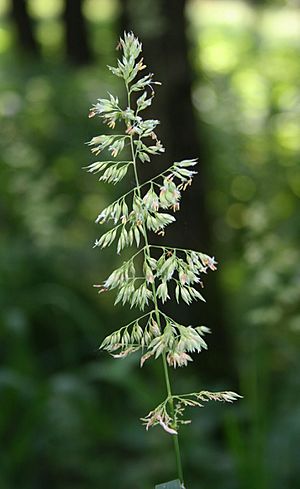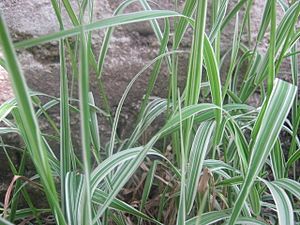Reed canary grass facts for kids
Quick facts for kids Reed canary grass |
|
|---|---|
 |
|
| Conservation status | |
| Scientific classification | |
| Genus: |
Phalaris
|
| Species: |
arundinacea
|

Phalaris arundinacea, also known as reed canary grass, is a tall plant that grows back every year. It is a type of grass that often forms large groups along the edges of lakes and rivers. You can find this grass in many parts of the world, including Europe, Asia, northern Africa, and North America. Some other common names for this plant are gardener's-garters in English, alpiste roseau in French, and hierba cinta in Spanish.
Contents
What Reed Canary Grass Looks Like
The stems of reed canary grass can grow up to 2 meters (about 6.5 feet) tall. Its leaves are usually green, but some types have stripes of different colors. The plant has flower clusters called panicles that can be up to 30 centimeters (about 12 inches) long. These flower clusters are light green and sometimes have darker green or purple stripes. This grass spreads underground using thick stems called rhizomes. These rhizomes help the plant grow new shoots and spread out.
How People Use Reed Canary Grass
People use reed canary grass for several things.
As an Ornamental Plant
Some types of reed canary grass are grown in gardens because they look nice. These types often have striped leaves and are sometimes called ribbon grass. Two examples are 'Castor' and 'Feesey', which can have a pink color on its leaves. Even though it can handle dry weather, this grass likes a lot of water and can even grow in water.
For Cleaning Up Land
Scientists have found that reed canary grass can help clean up polluted land. It grows well even in poor soil or places where factories used to be. This process is called phytoremediation, which means using plants to remove harmful things from the soil. This can help make the land healthier and better for other plants and animals.
For Energy and Materials
This grass can also be made into special bricks or pellets. These can be burned in power stations to create energy, like a type of biomass fuel. Reed canary grass also has strong fibers that can be used to make paper. Farmers sometimes grow it as a crop for hay or forage, which means it can be used to feed farm animals.
Why Reed Canary Grass Can Be a Problem
In many places, reed canary grass is an invasive species. This means it spreads very quickly and takes over areas where it doesn't belong, especially in wetlands. When it invades a wetland, it can push out the native plants that naturally grow there. This reduces the number of different types of plants and animals, which is called biological diversity. It can change the whole natural area. The grass spreads easily by its seeds and underground stems, and once it starts growing, it is very hard to get rid of.
Where Reed Canary Grass Grows
Reed canary grass is now found all over the world. Scientists believe it is native to both North America and Eurasia. However, there is some debate about this because the plants found in North America might be a mix of types brought from Europe and those that were already there.
See also
 In Spanish: Alpiste cinta para niños
In Spanish: Alpiste cinta para niños


